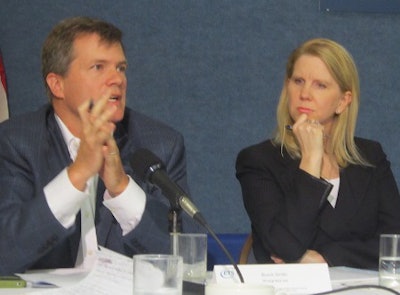 Burck Smith, CEO of StraighterLine, and Dr. Jennifer Stephens Helm, the dean and vice-president of institutional research and assessment for the American Public University System. (photo by Ronald Roach)
Burck Smith, CEO of StraighterLine, and Dr. Jennifer Stephens Helm, the dean and vice-president of institutional research and assessment for the American Public University System. (photo by Ronald Roach)WASHINGTON – With the advent of new digital technologies, not only is higher education innovation strengthening the connections between institutions and students, but it will also enable schools to better help their students connect with potential employers and transition into the workplace.
This is an outcome the Educational Testing Service expects will result from its recent moves to provide electronic documentation to test takers of their performance on the ETS Proficiency Profile and iSkills tests. Since earlier this year, those students taking the Proficiency Profile test, which measures reading, writing, math and critical thinking skills, have been able to acquire electronic certificates, which can be shared with potential employers and others. Since last December, students taking the iSkills assessment, which measures digital literacy, have been receiving electronic certificates that can be shared with recipients in and outside academic institutions.
“Direct measures of student learning outcomes are going to be [among] the things that drive what’s happening in digital higher education going forward,” proclaimed Dr. David Payne, vice president and chief operating officer of the ETS Higher Education division, Wednesday during a roundtable discussion on digital technology’s impact on higher education.
Along with representatives from ETS, which convened the discussion in downtown Washington, individuals from higher education companies, the Community College of Baltimore County and the American Public University System outlined both the opportunities and challenges institutions face with using new technologies to improve student learning and prepare students for the workforce.
Payne explained to an audience of journalists that the move to provide electronic certificates to Proficiency Profile and iSkills test takers resulted partly from research that said students would perform better if they were sufficiently motivated. Instead of the tests only being internally used by the colleges and universities as they initially were, ETS recognized that providing the shareable electronic certificates might motivate students to perform better while also providing employers stronger evidence of student ability.
“We took the motivation research and said one of the ways to improve the quality of the data we can provide back to the institution is by allowing the students to get a certificate at the end of the assessment that would indicate what their proficiency levels were,” Payne said.
“[Students] want to go out on the job market and differentiate themselves…So making the assessments valuable to learners and to higher education institutions is really a win-win for everybody,” he noted.
More than 600 higher education institutions annually test students with the Proficiency Profile exam, which has been used for two decades, according to ETS officials. Since 2011, 40 institutions have tested students using the iSkills assessment, which has been around since 2004.
Burck Smith, the CEO of StraighterLine online course company, said he believes that employers who have been accustomed to valuing potential hires based on their attainment of two- and four-year degrees will eventually accept non-degree learning credentials, such as certificates, with the same measure of confidence they have with traditional degrees. Smith, however, spoke extensively about how new higher education course providers and other vendors face a high bar of market entry, particularly if the vendor is not an accredited institution.
“New providers are entering and are held to a higher standard because they are not part of an accrediting system,” Smith said.
Although StraighterLine is not accredited as a traditional higher education institution, the Baltimore-based firm provides general education online courses whose credits have been accepted by more than 400 accredited colleges and universities. He said the firm, which was launched in 2008, is expected to serve nearly 20,000 students this academic year and has formal relationships with roughly 50 colleges and universities.
“We use proctoring services, we have [American Council of Education] credit recommendations; we’ve had other good housekeeping seals of approval because we don’t have that access to accreditation which allows you to be part of the system,” he explained.
Smith said that with firms, such as StraighterLine, facing tougher standards than traditional higher education institutions in driving innovation, employers will eventually come to value non-traditional credentials more than the ones that colleges and universities will provide. “At some point, employers will realize that these newer providers will offer assessments that have higher validity than the assessments that are coming from a proxy of a two-year or four-year degree,” he said.
Dr. Jennifer Stephens Helm, the dean and vice-president of institutional research and assessment for the American Public University System, said the for-profit, online university system, which enrolls more than 100,000 students from around the U.S. and the world, makes it a high priority to know what employers are seeking in potential hires and to fully utilize new technology for teaching and learning.
“We’re listening to employers and to industries on the types of knowledge, skills and abilities that our students need to thrive in today’s society,” she said.





















